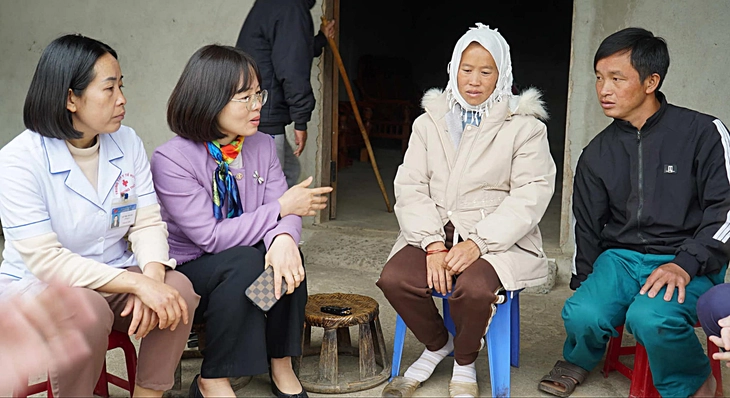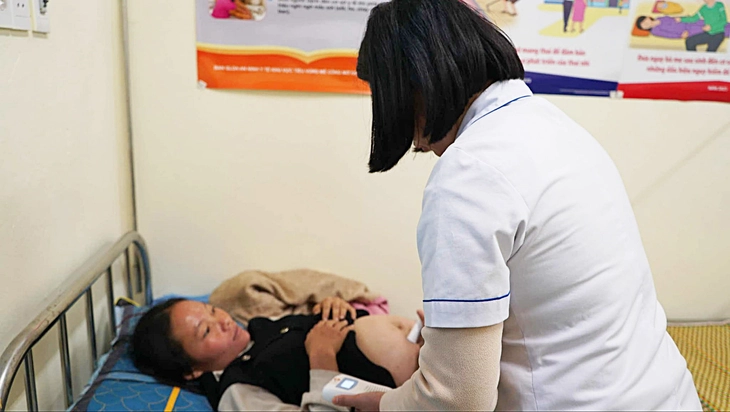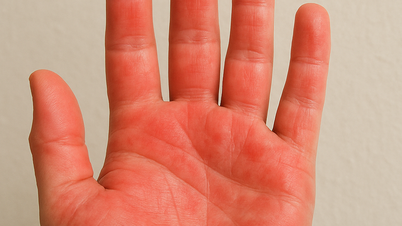Medical staff came to persuade the family of Mr. Ma Phu and Ms. Ly Thi Chu (Mu Sang commune, Phong Tho, Lai Chau) who were preparing to give birth to their second child to come to the medical facility to give birth - Photo: DUONG LIEU
Some children are born on the cold ground, and some don't even have time to cry...
Lost wife and child due to home birth
In the mountainous village of To Y Phin, Mo Si San commune, Phong Tho district, Lai Chau province, many people still cannot forget the tragic death of Ms. Phung Ta May while giving birth at home.
According to Ms. May's husband, they are preparing to welcome their fifth child. Throughout her pregnancy, Ms. May remained healthy. Like many women in To Y Phin village, she still went to the fields every day to collect firewood and pick bamboo shoots.
Ms. May's husband clearly remembers the day his wife went into labor and was about to give birth. That day was February 18, 2022. "In the evening, my wife started to have a stomachache, and the pain gradually increased.
Like the previous 4 births, my wife gave birth at home, gave birth and bathed the baby herself. This time, the whole family was prepared to welcome the baby at home. Late at night, my wife gave birth successfully, and a healthy, rosy-cheeked baby boy was born," Ms. May's husband recounted.
However, unlike previous births, her family saw that the placenta did not detach and there was a lot of bleeding, so they advised her to go to the medical station for a check-up.
Subjectively, because she had experience giving birth 4 times, Ms. May did not go. And then just over 2 hours later, the placenta still did not detach, she continued to bleed heavily, her limbs trembled, turned purple and died afterwards.
Ms. May passed away, leaving behind her husband and 5 young children. The newborn baby had never seen his mother and the older children had never seen their mother again.
In Na Tria village, Sam Kha commune, Sop Cop district, Lao Cai, for nearly 2 years, Mr. GDC has not been able to forget the pain of losing both his wife and newborn child in early 2023.
In a village in the highlands of Sop Cop district, Mr. C. said that many people in his village give birth at home, some have given birth to 4-5 healthy children. Therefore, many villagers still "tell each other" that it is okay to give birth at home.
The day Mr. C.'s wife went into labor, it was so quick that Mr. C. only had time to call the midwife - who often delivered babies at home for the villagers - to come. After 30 minutes of giving birth, the baby stopped crying and did not survive. His wife was also bleeding profusely, and although the whole family tried to take her to the emergency room, she did not survive on the way.
Having just lost his child and his wife, Mr. C. could only regret that during the 9 months and 10 days his wife was pregnant, he never once took her to the medical station for a check-up.
"I am very regretful. If I had paid more attention to the pregnancy and taken my wife for regular ultrasounds, registered for maternity management and taken her to a medical facility to give birth, this sad incident would not have happened," Mr. C. said sadly.
Giving birth at home because "it's always been that way"
Coming to Mu Sang Village Health Station, Phong Tho District, Lai Chau Province for a pregnancy check-up, Ms. Giang Thi Sua shared that this was her fourth pregnancy and the previous three times she gave birth at home.
When asked if giving birth at home was not dangerous, Ms. Sua shyly said: "Yes, but my husband and mother-in-law both said that giving birth at home was fine, everyone had given birth at home before, so I listened.
"I and some other women in the village wanted to go to the health station to give birth. But partly because we were shy, and partly because it was customary to have a midwife at home, it had become a habit. Here, giving birth at home is common, few people go to the hospital," Ms. Sua shared.
Like Ms. Sua, the family of Mr. Giang A Lung (22 years old) and Ms. Ly Thi So (21 years old), in Xin Chai village (Mu Sang, Phong Tho) two years ago, also gave birth to their first child at home. "In the past, parents and grandparents still gave birth at home, so when it was my wife and I's turn, we also chose to give birth at home like our ancestors," said Mr. Lung.
Ms. Pang is 23 years old this year, but has 3 children, the youngest is just over 1 month old and all 3 of her children were born at home. When asked why she did not go to the medical station to give birth, Ms. Pang said: "Because the road is too far, and she has no money, so she gave birth at home."
Although ethnic minority mothers in the highland provinces all have health insurance cards and do not have to pay hospital fees when going to hospitals or health stations, many still choose to give birth at home. Many still think that going to a medical facility will be expensive.
Besides, when pregnant, women in highland and ethnic minority areas have few opportunities for regular prenatal check-ups, because Mong people often live in the mountains, where roads are difficult to travel and far from medical stations.
Because they do not have regular check-ups, pregnant women do not know their due date to prepare for childbirth. Newborns often have their umbilical cords cut with knives or scissors available at home; sometimes people split bamboo trees to make knives to cut the umbilical cord. This custom has caused many mothers and children to die when giving birth at home.
Maternal and child mortality rates remain high
According to statistics from the United Nations Population Fund (UNFPA), in Vietnam, although the national maternal mortality rate has decreased to 46%/100,000 live births in recent years, this number is still very high in mountainous areas and ethnic minority areas (100-150 cases/100,000 live births), especially in the midlands, northern mountainous areas and the Central Highlands.
One study found that among reported maternal deaths in mountainous areas, rates were higher among some ethnic groups such as the Mong (60%) and Thai (17%). The risk of death during pregnancy or childbirth among Mong mothers is estimated to be four times higher than that of Kinh mothers.
The main cause of maternal mortality in ethnic minority areas is childbirth at home. Accordingly, maternal deaths occurring at and or on the way to the hospital accounted for 47.2%. This shows that ethnic minority mothers are slow to go to medical facilities, and when in critical condition, emergency care is too late.
Helpless to convince pregnant women
Ms. Lo Thi Thanh, a medical officer, examines a pregnant woman at the Mu Sang Commune Health Station, Phong Tho District, Lai Chau Province - Photo: DUONG LIEU
Having worked with the people of Mu Sang commune, Phong Tho district, Lai Chau province for 18 years, Ms. Lo Thi Thanh, a medical practitioner working at Mu Sang commune health station, shared that she sometimes feels helpless because she cannot convince mothers to go to medical facilities for prenatal check-ups and childbirth.
"Because the custom of giving birth at home has been ingrained from generation to generation, it cannot be changed overnight. In addition to geographical reasons, there are also psychological barriers for ethnic minorities. Many women are very shy and embarrassed," Ms. Thanh shared.
Ms. Thanh said that Mong people are very shy when going to gynecological examinations and giving birth at the health station because they are afraid that "the medical staff (medical staff at the station - reporter) will see us, we see the medical staff every day, so we will be shy and embarrassed".
According to Ms. Thanh, the Mong people's custom is that only relatives, husbands, and mothers are allowed to look at their "reproductive organs". Because of "embarrassment", many people do not dare to go to medical facilities to give birth or have a pregnancy check-up.
Ms. Mua Thi Sua (24 years old, in Mu Sang commune) also shared that women in the village often listen to their husbands and mothers-in-law to give birth at home. If the family does not take the child to the health station, they have to accept giving birth at home.
Danger of urban women following the trend of "natural childbirth"
The "natural birth" trend emerged in 2019. At that time, with the participation of many ministries, sectors, mass media and public opinion, this trend was suppressed. However, recently, this unscientific trend, which poses many risks to mothers and newborns, has reappeared on social networks.
Most notably, in 2024, an account posted a picture of a woman who had just given birth soaking in a tub of water, holding a still-purple newborn baby in her arms, along with the caption.
**********
>> Next: So that every mother can give birth in the light
Read moreBack to Topic Page
WILLOW
Source: https://tuoitre.vn/nguy-hiem-sinh-con-tai-nha-ky-1-mat-vo-mat-con-vi-sinh-con-thuan-tu-nhien-20250414082954152.htm






![[Photo] General Secretary To Lam concludes visit to Russia, departs for Belarus](https://vphoto.vietnam.vn/thumb/1200x675/vietnam/resource/IMAGE/2025/5/11/0acf1081a95e4b1d9886c67fdafd95ed)


![[Photo] General Secretary To Lam arrives in Minsk, begins state visit to Belarus](https://vphoto.vietnam.vn/thumb/1200x675/vietnam/resource/IMAGE/2025/5/11/76602f587468437f8b5b7104495f444d)

















![[Photo] National Assembly Chairman Tran Thanh Man attends the Party Congress of the Committee for Culture and Social Affairs](https://vphoto.vietnam.vn/thumb/1200x675/vietnam/resource/IMAGE/2025/5/11/f5ed02beb9404bca998a08b34ef255a6)































































Comment (0)